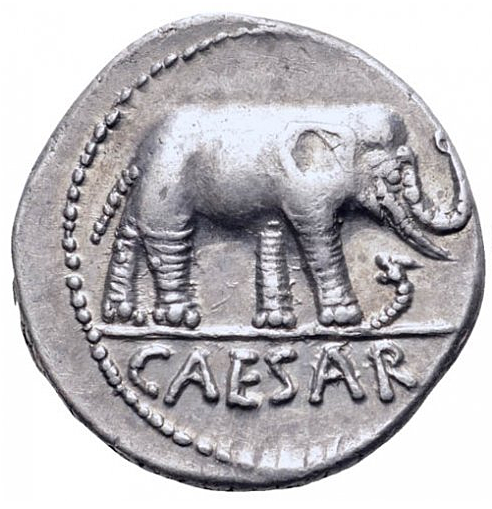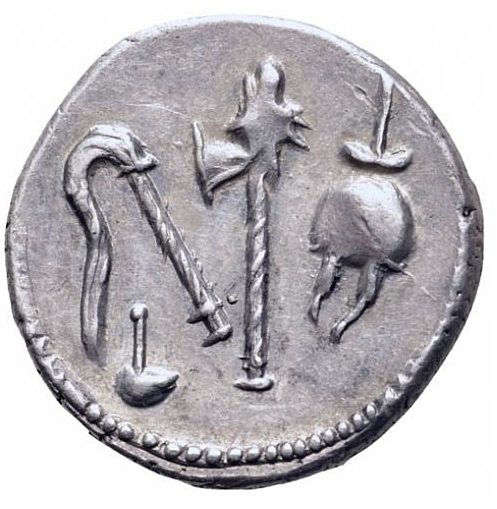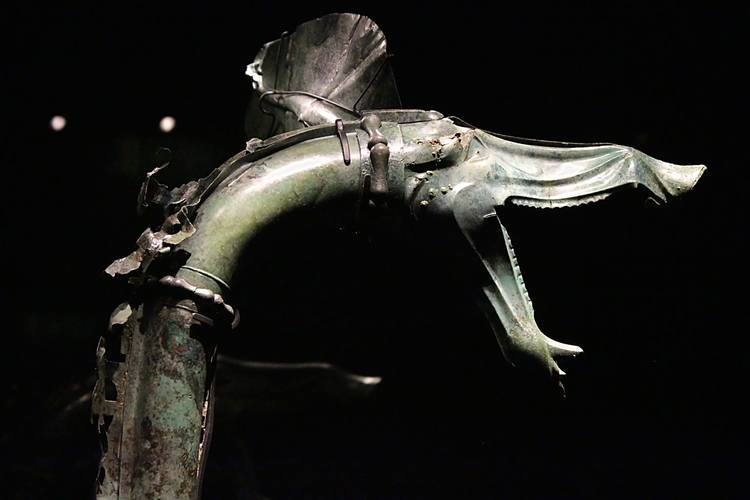Romerska republiken, Julius Caesar, Vacker Elefantdenar
Produkten är tyvärr slut i lager. :(
ROMAN REPUBLIC (Redan såld)
Julius Caesar AR Denarius. Military mint travelling with Caesar, 49-48 BC. Elephant advancing right, trampling on serpent; CAESAR in exergue / Emblems of the pontificate: simpulum, aspergillum, securis (surmounted by wolf's head), and apex. Crawford 443/1; CRI 9; RSC 49; BMCRR Gaul 27-30. 3.69g, 17mm, 11h. (såld)
About Extremely Fine. Nice tone with bold strike and pleasantly detailed. A classic type coin of great historical significance.
.
Interpretation and discussion of depiction on obverse
"Elephant advancing right, trampling on serpent; CAESAR in exergue" We can without question agree that coin is depiction elephant, but as for the serpent it raises doubts. Is it really a serpent, is it not a Carnyx? Interpretation of the underlying message of Elephant and snake (Carnyx) give us slightly different angle to the propaganda conveyed in this coin. If it is a Elephant (without any specific historical connotations) and if it is a snake (with ears) than the standard propaganda interpretations is Caesar crushing his enemies, the Pompeian fraction (snakes). The coin is minted by a military mint moving with Caesar in the opening months of the Civil War (April to August 49 BC, shortly after the conclusion off the Gallic wars and around the time of crossing Rubicon.
.
Snake or Carnyx
Is it really a snake under the Elephants foot or is it more likely a Carnyx! As far as I know, no snake has ever had ears, but if you check contemporary republican coinage there is several coins depicting Carnyx which is quite similar to the one on this issue from Julius Caesar. Also if you check ancient Carnyx Archeological finds you will find a striking resemblance between actual Carnyx and depiction in this coin. Se image inserted below.
Source: By Claude Valette - Own work, CC BY-SA 3.0, https://commons.wikimedia.org/w/index.php?curid=20767233
.
Carnyx
The Carnyx was an instrument of Celts, commonly used in republican days. It was a type of bronze trumpet that was used in warfare, probably to incite troops to battle and intimidate opponents. The instrument's significant height allowed it to be heard over the heads of the participants in battles or ceremonies. The bell was styled in the shape of an open-mouthed boar's, or other animal's, head.
.
Symbolism
The simplest explanation is often the most correct! If you take into consideration that Julius Caesar after almost ten years conquering Gaul set upon his adversaries in Rome, would he not use his recent victories as propaganda to intimidate his opponents! - the Pompejan party!
.
This is pure speculation from my side and I have no real foundation for this, but think about this - still very much alive in Roman conscious - Hannibal and his Elephants crossing the Alps just a few generations earlier, the very same route taken by Caesar. Hannibal was waging war at will in Italy, defeating any opposition thrown at him. The most traumatic incident in Roman history was the defeat at Cannae in august 216 BC, where the numeric superior Roman army was encircled and annihilated to the last man - the worst defeat inflicted on any Roman army with 50.000 slaughtered.
.
So my guess - using this frightful symbol of the Elephant crushing the Gallic Carnyx - is a clear message to the Pompejans - this is what is coming to you too! Elephant would be the symbol for unbeatable force and the Carnyx would symbolize massive victories, destruction and enslavement for the loosing side. and (again - pure speculation...)


